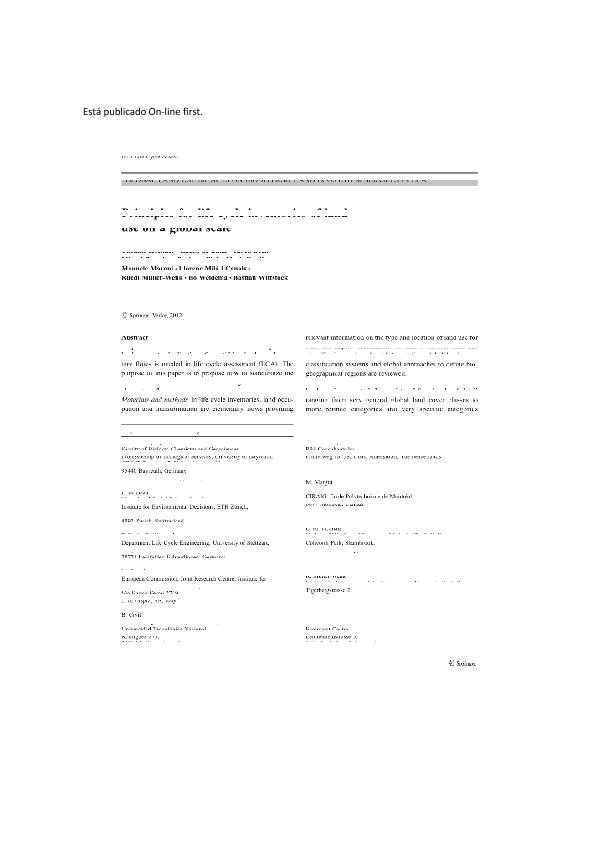Mostrar el registro sencillo del ítem
dc.contributor.author
Koellner, Thomas
dc.contributor.author
De Baan, Laura
dc.contributor.author
Beck, Tabea
dc.contributor.author
Brandão, Miguel
dc.contributor.author
Civit, Bárbara María

dc.contributor.author
Goedkoop, Mark
dc.contributor.author
Margni, Manuele
dc.contributor.author
Milà i Canals, Llorenç
dc.contributor.author
Müller Wenk, Ruedi
dc.contributor.author
Weidema, Bo
dc.contributor.author
Wittstock, Bastian
dc.date.available
2017-04-07T15:11:36Z
dc.date.issued
2013-07
dc.identifier.citation
Koellner, Thomas; De Baan, Laura; Beck, Tabea; Brandão, Miguel ; Civit, Bárbara María; et al.; Principles for life cycle inventories of land use on a global scale; Springer Heidelberg; International Journal Of Life Cycle Assessment; 18; 6; 7-2013; 1203-1215
dc.identifier.issn
0948-3349
dc.identifier.uri
http://hdl.handle.net/11336/14959
dc.description.abstract
Purpose To assess the diverse environmental impacts of land use, a standardization of quantifying land use elementary flows is needed in life cycle assessment (LCA). The purpose of this paper is to propose how to standardize the land use classification and how to regionalize land use elementary flows. Materials and methods In life cycle inventories, land occupation and transformation are elementary flows providing relevant information on the type and location of land use for land use impact assessment. To find a suitable land use classification system for LCA, existing global land cover classification systems and global approaches to define biogeographical regions are reviewed. Results and discussion A new multi-level classification of land use is presented. It consists of four levels of detail ranging from very general global land cover classes to more refined categories and very specific categories indicating land use intensities. Regionalization is built on five levels, first distinguishing between terrestrial, freshwater, and marine biomes and further specifying climatic regions, specific biomes, ecoregions and finally indicating the exact geo-referenced information of land use. Current land use inventories and impact assessment methods do not always match and hinder a comprehensive assessment of land use impact. A standardized definition of land use types and geographic location helps to overcome this gap and provides the opportunity to test the optimal resolution of land cover types and regionalization for each impact pathway. Conclusions and recommendation The presented approach provides the necessary flexibility to providers of inventories and developers of impact assessment methods. To simplify inventories and impact assessment methods of land use, we need to find archetypical situations across impact pathways, land use types and regions, and aggregate inventory entries and methods accordingly.
dc.format
application/pdf
dc.language.iso
eng
dc.publisher
Springer Heidelberg

dc.rights
info:eu-repo/semantics/openAccess
dc.rights.uri
https://creativecommons.org/licenses/by-nc-sa/2.5/ar/
dc.subject
Global
dc.subject
Land Cover
dc.subject
Life Cycle Assessment
dc.subject
Regionalization
dc.subject.classification
Otras Ingeniería del Medio Ambiente

dc.subject.classification
Ingeniería del Medio Ambiente

dc.subject.classification
INGENIERÍAS Y TECNOLOGÍAS

dc.title
Principles for life cycle inventories of land use on a global scale
dc.type
info:eu-repo/semantics/article
dc.type
info:ar-repo/semantics/artículo
dc.type
info:eu-repo/semantics/publishedVersion
dc.date.updated
2016-09-19T18:44:05Z
dc.journal.volume
18
dc.journal.number
6
dc.journal.pagination
1203-1215
dc.journal.pais
Alemania

dc.journal.ciudad
Berlín
dc.description.fil
Fil: Koellner, Thomas. University of Bayreuth. Faculty of Biology, Chemistry and Geosciences. Professorship of Ecological Services; Alemania
dc.description.fil
Fil: De Baan, Laura. Natural and Social Science InterfaceInstitute for Environmental Decisions; Alemania
dc.description.fil
Fil: Beck, Tabea. University of Stuttgart. Department Life Cycle Engineering; Alemania
dc.description.fil
Fil: Brandão, Miguel . European Commission. Joint Research CentreInstitute for Environment and Sustainability. Sustainability Assessment Unit; Italia
dc.description.fil
Fil: Civit, Bárbara María. Consejo Nacional de Investigaciones Científicas y Técnicas. Centro Científico Tecnológico Mendoza. Instituto de Ciencias Humanas, Sociales y Ambientales; Argentina. Universidad Tecnologica Nacional; Argentina
dc.description.fil
Fil: Goedkoop, Mark. PRé Consultants bv; Países Bajos
dc.description.fil
Fil: Margni, Manuele. École Polytechnique de Montréal. Département de génie chimique; Canadá
dc.description.fil
Fil: Milà i Canals, Llorenç. Central Resources Limited. Unilever U.K.; Reino Unido
dc.description.fil
Fil: Müller Wenk, Ruedi. University St. Gallen. Institute for Economy and the Environment; Suiza
dc.description.fil
Fil: Weidema, Bo. Ecoinvent Centre; Suiza
dc.description.fil
Fil: Wittstock, Bastian. Ecoinvent Centre; Suiza
dc.journal.title
International Journal Of Life Cycle Assessment

dc.relation.alternativeid
info:eu-repo/semantics/altIdentifier/url/https://link.springer.com/article/10.1007%2Fs11367-012-0392-0
dc.relation.alternativeid
info:eu-repo/semantics/altIdentifier/url/http://dx.doi.org/10.1007/s11367-012-0392-0
Archivos asociados
